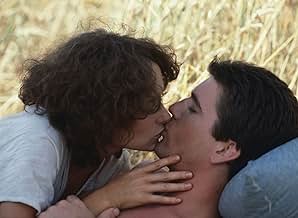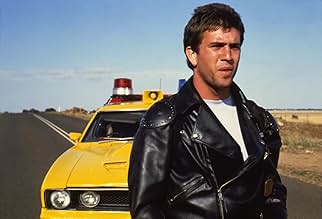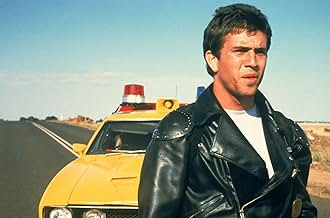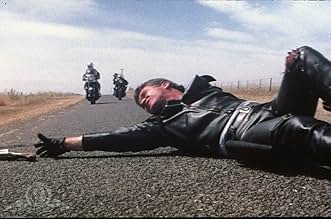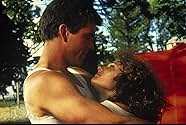In a self-destructing world, a vengeful Australian policeman sets out to stop a violent motorcycle gang.In a self-destructing world, a vengeful Australian policeman sets out to stop a violent motorcycle gang.In a self-destructing world, a vengeful Australian policeman sets out to stop a violent motorcycle gang.
- Awards
- 6 wins & 8 nominations
Storyline
Did you know
- TriviaMost of the extras used in the film were paid in beer.
- GoofsWhen Jessie walks to the car Max is repairing she is wearing sneakers. When she walks around to the passenger side of the car she has on boots with sheepskin trim. When she walks off to the beach she is wearing the deck shoes again.
- Quotes
[the Kid is handcuffed to a car that's about to explode]
Max: The chain in those handcuffs is high-tensile steel. It'd take you ten minutes to hack through it with this. Now, if you're lucky, you could hack through your ankle in five minutes. Go.
[the hacksaw is dropped next to The Kid, and Max limps off]
- Alternate versionsThe original UK cinema and certified video releases (American dub) were cut by 48 seconds by the BBFC to keep an X (18) rating and to prevent the film from being banned, as X was the highest rating. They edited the scene where the bikers tear up the hot-rod with the terrified couple inside. Instead, the scene cut to black as the bikers smashed the first window and resumed on the bird hovering overhead. Though the original uncertified 1982 video release of the American dub from Warner Home Video was released uncut, the cut was re-instated on the 1986 18-rated VHS, but was restored in 1992 when the Australian dialogue version was finally released in the UK and to all later releases with the same rating (although Warner's budget labels SCREEN CLASSICS still put out the American dub with the cut scene well into the 90s). In April 2015, the film was passed with a 15 rating uncut, because of "(the scene's) implied nature and lack of visual detail of the acts themselves". The same reason was given for passing it at 18 uncut back in 1992.
- ConnectionsEdited into Mad Max 2: The Road Warrior (1981)
- SoundtracksLicorice Road
(uncredited)
Written and Produced by Nic Gazzana
Performed by Robina Chaffey
Sung by Creenagh St. Clair
Featured review
Dr. George Miller's low budget Mad Max franchise impacted on Australian culture and altered the perception of Australia and Australians overseas in a way that no other Australian film had done. The films explores themes such as 'man and the environment', 'fear provoking post-apocalyptic future, family', 'masculinity in crisis', 'good versus evil (Max as an iconic hero), Australian ethos and car culture; themes often featured within Australian films yet presented in a stark and dramatic way. The cinematographic impact is powerful; the human and emotional appeal is timeless.
Australia's barren deserts presented the ideal setting for a post-apocalyptic environment. The film set is more identifiable as Australia as it was filmed around the city of Melbourne. Long deserted roads feature significantly in the film and the cinematographic device of taking long distant shots of Max demonstrates how small he is in the scale of the environment that he is living. It is a relentless, unforgiving environment which demands defeat or survival and marks the characters which play upon its stage.
Just as the physical setting is stark and desolate, the time setting and its associated events create an atmosphere of fear and foreboding which plays on the minds and emotions of contemporary viewers. In this fear provoking post apocalyptic future the few survivors of the nuclear holocaust are in warfare with one another, the rebel bikers and the police.
Good versus evil is a dominant discourse in many film genres and one which embraces the Australian ethos. Max possesses some highly valued "Australian" traits; in particular, those of the underdog, the battler, the hero. External forces beyond his control stop him from "winning" completely. Contrary to the Hollywood hero, the Australian hero is a pawn in the game of others, which explains why Max can never quite "win" in absolute terms. There is little public glorification of success in Australia; heroes are remembered for their style rather than for their achievements. (Venkatasawmy, 1996) Mad Max represented a tradition hero, a hero to whom many diverse cultures are able to relate, as a story of a lone hero is a story that goes back through centuries of storytelling, and as a consequence the film achieved colossal success within Australian and around the world. The Australian cultures and lifestyles shown throughout these films give Australians an understanding of their country in the landscape, the language, and the way we treat people, life and life in exceptional circumstances.
Reference Venkatasawmy, R. (1996), Australian Film in the Reading Room: The Hybridity of Film-making in Australian National Cinema: Formulating a Cinematic Post-Diaspora. Retrieved March 14, 2005, from http://wwwmcc.murdoch.edu.au/ReadingRoom/rama/CHAPT4.htm
Australia's barren deserts presented the ideal setting for a post-apocalyptic environment. The film set is more identifiable as Australia as it was filmed around the city of Melbourne. Long deserted roads feature significantly in the film and the cinematographic device of taking long distant shots of Max demonstrates how small he is in the scale of the environment that he is living. It is a relentless, unforgiving environment which demands defeat or survival and marks the characters which play upon its stage.
Just as the physical setting is stark and desolate, the time setting and its associated events create an atmosphere of fear and foreboding which plays on the minds and emotions of contemporary viewers. In this fear provoking post apocalyptic future the few survivors of the nuclear holocaust are in warfare with one another, the rebel bikers and the police.
Good versus evil is a dominant discourse in many film genres and one which embraces the Australian ethos. Max possesses some highly valued "Australian" traits; in particular, those of the underdog, the battler, the hero. External forces beyond his control stop him from "winning" completely. Contrary to the Hollywood hero, the Australian hero is a pawn in the game of others, which explains why Max can never quite "win" in absolute terms. There is little public glorification of success in Australia; heroes are remembered for their style rather than for their achievements. (Venkatasawmy, 1996) Mad Max represented a tradition hero, a hero to whom many diverse cultures are able to relate, as a story of a lone hero is a story that goes back through centuries of storytelling, and as a consequence the film achieved colossal success within Australian and around the world. The Australian cultures and lifestyles shown throughout these films give Australians an understanding of their country in the landscape, the language, and the way we treat people, life and life in exceptional circumstances.
Reference Venkatasawmy, R. (1996), Australian Film in the Reading Room: The Hybridity of Film-making in Australian National Cinema: Formulating a Cinematic Post-Diaspora. Retrieved March 14, 2005, from http://wwwmcc.murdoch.edu.au/ReadingRoom/rama/CHAPT4.htm
- MrBenWhite
- Apr 7, 2005
- Permalink
Details
- Release date
- Country of origin
- Language
- Also known as
- Pobješnjeli Max
- Filming locations
- Seaford Beach, Seaford, Victoria, Australia(Toecutter gang beach scenes)
- Production companies
- See more company credits at IMDbPro
Box office
- Budget
- $300,000 (estimated)
- Gross US & Canada
- $8,750,000
- Gross worldwide
- $8,773,932
- Runtime1 hour 28 minutes
- Color
- Sound mix
- Mono(original release)
- DTS
- Dolby Digital
- Aspect ratio
- 2.39 : 1
Contribute to this page
Suggest an edit or add missing content






